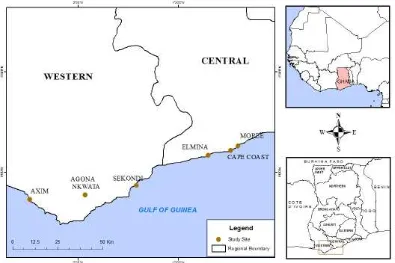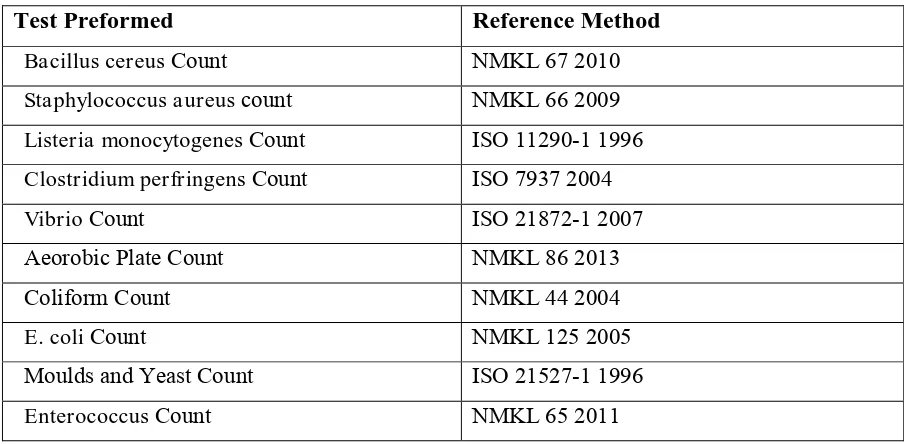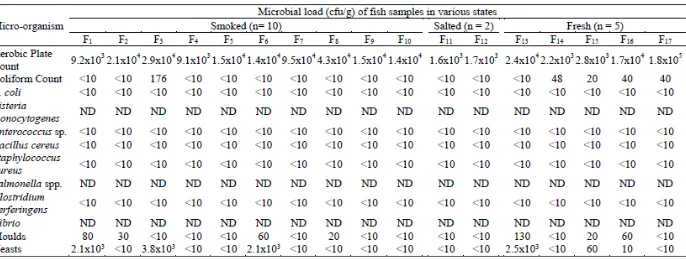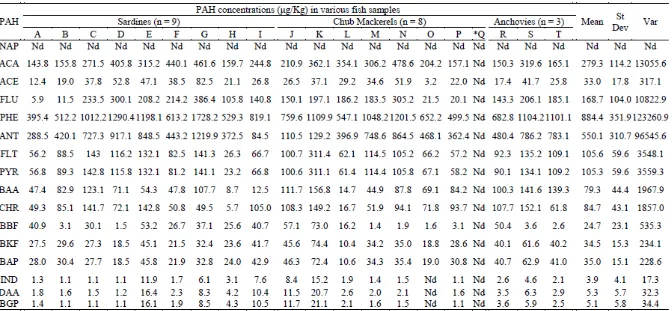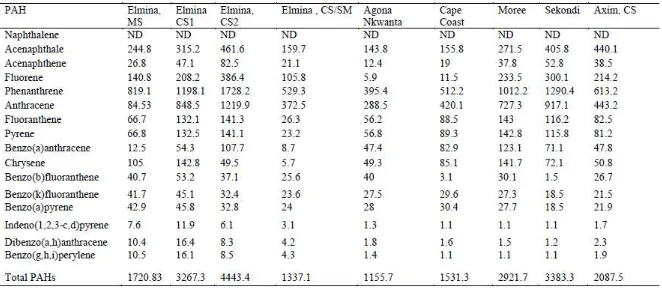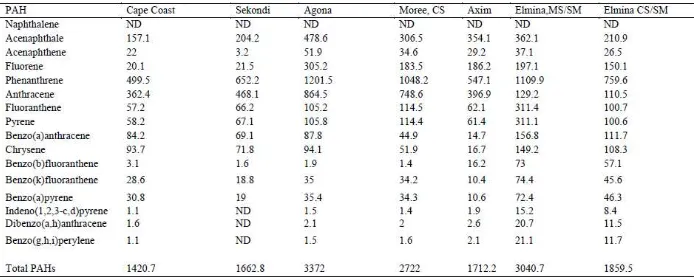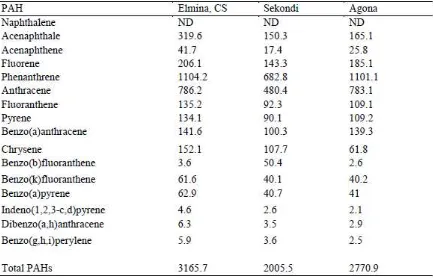SUSTAINABLE FISHERIES
MANAGEMENT PROJECT (SFMP)
Microbiological (PAHs) Analysis Of
Fish From Selected Areas From
Central And Western Regions Of
Ghana
This publication is available electronically in the following locations: The Coastal Resources Center
http://www.crc.uri.edu/projects_page/ghanasfmp/
Ghanalinks.org
https://ghanalinks.org/elibrary search term: SFMP USAID Development Clearing House
https://dec.usaid.gov/dec/content/search.aspx search term: Ghana SFMP
For more information on the Ghana Sustainable Fisheries Management Project, contact: USAID/Ghana Sustainable Fisheries Management Project
Coastal Resources Center
Graduate School of Oceanography University of Rhode Island
220 South Ferry Rd.
Narragansett, RI 02882 USA
Tel: 401-874-6224 Fax: 401-874-6920 Email: info@crc.uri.edu
Citation: Aheto, D. W., Adinortey, C. A., Essumang, D. K., Adjei, J. & Ahadzi, E. Kwarteng E. Avega B. (2017). Microbiological and Polycyclic Aromatic Hydrocarbons (PAHs) Analysis of Fish from selected Areas from Central and Western Regions of Ghana. The USAID/Ghana Sustainable Fisheries
Management Project (SFMP). Narragansett, RI: Coastal Resources Center, Graduate School of Oceanography, University of Rhode Island and SNV Netherlands Development Organisation. GH2014_ACT065_SNV. 29 pp. Authority/Disclaimer:
Prepared for USAID/Ghana under Cooperative Agreement (AID-641-A-15-00001), awarded on October 22, 2014 to the University of Rhode Island, and entitled the USAID/Ghana Sustainable Fisheries Management Project (SFMP).
This document is made possible by the support of the American People through the United States Agency for International Development (USAID). The views expressed and opinions contained in this report are those of the SFMP team and are not intended as statements of policy of either USAID or the cooperating organizations. As such, the contents of this report are the sole responsibility of the SFMP team and do not necessarily reflect the views of USAID or the United States Government.
Detailed Partner Contact Information:
USAID/Ghana Sustainable Fisheries Management Project (SFMP) 10 Obodai St., Mempeasem, East Legon, Accra, Ghana
Telephone: +233 0302 542497 Fax: +233 0302 542498 Maurice Knight Chief of Party maurice@crc.uri.edu
Kofi Agbogah Senior Fisheries Advisor kagbogah@henmpoano.org Nii Odenkey Abbey Communications Officer nii.sfmp@crcuri.org
Bakari Nyari Monitoring and Evaluation Specialist hardinyari.sfmp@crcuri.org Brian Crawford Project Manager, CRC brian@crc.uri.edu
Ellis Ekekpi USAID AOR (acting) eekekpi@usaid.gov
For additional information on partner activities:
CRC/URI: http://www.crc.uri.edu
CEWEFIA: http://cewefia.weebly.com/
DAA: http://womenthrive.org/development-action-association-daa Friends of the Nation: http://www.fonghana.org
Hen Mpoano: http://www.henmpoano.org
ACRONYMS
ACN Acetonitrile
AOR Agreement Officer’s Representative CRC Coastal Resource Center
CSIR Council for Scientific and Industrial Research
DI De-ionized Water
EU European Union
FAO Food and Agricultural Organization FACP Fishery and Aquaculture Country profiles GC/MS Gas Chromatography/ Mass Spectrometry GDP Gross Domestic Product
GSA Ghana Standard Authority
HPLC High Performance Liquid Chromatography ISO International Standards Organization
NMKL Nordic Committee on Food Analysis Method MOFA Ministry of Food and Agriculture
MSD Mean Square Displacement
QC Quality Control
PAHs Polycyclic Aromatic Hydrocarbons
SFMP Sustainable Fisheries Management Project SNV Netherlands Development Organization TEF Toxic equivalency factors
TEQ Toxic Equivalent Quantity UCC University of Cape Coast
TABLE OF CONTENTS
SECTION 2 MATERIALS AND METHODS ... 4
2.1 Study Sites and Sample Collection ... 4
2.2 Determination of PAHs levels in fish samples ... 4
2.3 Carcinogenic Risk Assessment Using TEF (TEQ) ... 5
2.4 Microbial Analysis ... 6
2.5 Statistical Analysis ... 7
SECTION 3: RESULTS AND DISCUSSION ... 7
3.1 Microbial profile on fish samples ... 7
3.2 Polycyclic aromatic hydrocarbon (PAH) profile of fish samples ... 9
3.3 Human Health Risk Assessment ... 11
SECTION 4 CONCLUSIONS ... 12
4.1 Limitations of the study ... 12
4.2 Recommendations ... 12
SECTION 5 REFERENCES... 13
APPENDIX 1 ANALYTICAL TEST REPORT ON PAHS LEVELS IN FISH SAMPLES . 14 APPENDIX 2 TEST REPORT ON MICROBIAL PROFILES OF FISH SAMPLES ... 19
LIST OF FIGURES
Figure 1 Geographic locations of study sites (Source: Centre for Costal Management)... 4
LIST OF TABLES
Table 1 Toxicity Equivalency Factors (TEFs) ... 6 Table 2 Microbiological tests performed on fish samples ... 7 Table 3 Microbial profiles of smoked, salted and fresh fish samples ... 8 Table 4 Polycyclic Aromatic Hydrocarbon (PAH) levels in smoked and fresh fish samples . 10 Table 5 PAH levels (μg/kg) in smoke sardines on the Ghanaian market ... 14 Table 6 PAH levels (μg/kg) in smoked Chub Mackerel samples from the Ghanaian market . 15 Table 7 Levels of PAH (μg/kg) in smoked Engraulis encrasicolus ... 16 Table 8 Benzo A pyrene equivalence dose ... 17 Table 9 Cancer risk assessment using TEF/TEQ for smoked Mackerel product on the
SECTION 1 BACKGROUND
1.1 General Context
Ghana is significantly endowed with valuable fish stocks and a strong tradition and culture of fishing comparable to other West African nations. Indeed, the country produces on the average 440,000 tons of fish from its waters each year. Ghana is both an exporter and importer of fish.
Over the years, Ghana has exported large volumes of fish to international markets and as many as 2.2 million people in Ghana are dependent on the sector for their livelihoods, including some 135,000 fisher men and women in the marine sector alone. Revenues from the fisheries sector accounts for about US$1 billion per year, contributing at least 4.5 percent to Ghana’s GDP. Ghana’s fish also contribute indirectly to regional food self-sufficiency through trade and exports. As a matter of fact, the country is a regular supplier of smoked fish to neighboring countries such as Togo, Benin, Cote d’Ivoire and Nigeria. It is noteworthy that fish supplies naturally augment food availability. Fish availability ensures food security and good nutritional outcomes particularly of poor and rural populations. Particularly, fisheries products supply 60 percent of the animal protein consumed in the country and per capita fish consumption is 27 kg per year – more than double the world average.
Fresh, but more often smoked, dried, or even as powder, fish is a critical source of dietary protein and micronutrients such as iron, iodine, zinc, calcium, vitamin A and vitamin B for many communities in rural areas particularly in the poorest regions of Ghana. Therefore, fish is an important source of animal protein in Ghana with 75 % of the total annual domestic production of fish consumed locally (MOFA, 2017). In spite of this, imports of fish into the country are often made (FACP, 2016), suggesting that the local supply is insufficient for the high demand. Currently, Ghana is the number one fish consumer in the world (FACP, 2016). The traditional methods of fish processing and preservation comprise smoking, drying, frying, salting and fermenting and in some circumstances a combination of these methods. It had been reported that 95% of fish processed in Ghana is smoked, 3 % salted while the remainder is dried, fried or fermented (SMFP, 2015).
Unfortunately, the fish production in the country is confronted with a number of challenges. It is worthy to note that fish is exposed to microbial and chemical contamination right from the catch, through the processing, storage and final display at various local markets.
Microorganisms may either be beneficial or pathogenic and the determination of the microbial status of food usually connotes the hygiene conditions under which the fish was handled. Smoking preserves and enhances flavor; however, as the fish gets in contact with the smoke from the firewood, polycyclic aromatic hydrocarbons (PAHs) are formed which are released into the product.
PAHs are a class of high lipophilic compounds that comprise of chemical compounds known to be potent carcinogens (Simko, 2002). Structurally, they consist of one or more aromatic ring and their structure is known to influence their toxicity. They are produced from the incomplete combustion of organic matter and exist in mixtures. So far, more than 600 PAH compounds have been identified.
The smoking industry in Ghana is largely unregulated with various oven types, hygienic issues and wood fuels used for smoking; as such the quality of smoked fish varies from place to place. Fish smoked in Ghana is sold in-country with some units exported to other regional markets. Accessing the EU market has however proven quite difficult as the Union demands adherence to stringent regulations and standards regarding the sourcing, handling and processing of smoked fish. Amongst such standards, is the limit of Polycyclic Aromatic Hydrocarbons in smoked fish.
The research focused on quantifying the various PAH levels in different fish species of both smoked and fresh fish on the Ghanaian market to be able to provide scientific information and risk exposure to the ordinary consumer. Further analysis into microbiological profiles of fish both smoked and fresh was carried out by sampling fish from the popular sales points and markets in Ghana to be able to determine their contamination levels.
It is based on these results and existing information (from FAO and others) that SNV in consultation with project partners and national stakeholders aim to develop smoked fish production protocols to reduce contamination levels in smoked fish.
1.2 Project Background
The United States Agency for International Development (USAID) has committed funds to the implementation of a Sustainable Fisheries Management Project (SFMP) in Ghana for five years. The objective is to rebuild marine fisheries stocks and catches through adoption of responsible fishing practices. The project will contribute to the Government of Ghana’s fisheries development objectives and USAID’s Feed the Future Initiative.
Working closely with the Ministry of Fisheries and Aquaculture Development and the
Fisheries Commission, USAID/Ghana SFMP aims to end overfishing of key stocks important to local food security through a multi-pronged approach:
• Improved legal enabling conditions for co-management, use rights and effort-reduction strategies.
• Strengthened information systems and science-informed decision-making
• Increased constituencies that provide the political and public support needed to rebuild fish stocks.
• Implementation of applied management initiatives for several targeted fisheries ecosystems.
USAID selected the Coastal Resources Center (CRC) at The University of Rhode Island’s Graduate School of Oceanography as lead implementer of the SFMP. In leading the project, CRC will work with The Ministry of Fisheries and Aquaculture Development and the Fisheries Commission along with a consortium of international and local partners, including SNV Netherlands Development Organization.
SNV as part of its Year 2 implementing activities worked with UCC to carry out research into the production of smoked fish with low PAH levels. Also with UCC, SNV conducted
microbiological profiles on smoked fish to assess contamination levels. This study aimed at identifying the levels of various PAHs and to determine the microbial profiles of various fish samples in Ghana.
1.3 Objectives
Specific objectives
The objectives of the study were:
To provide scientific evidence on smoked fish production to guide the promotion of improved processing methods, product quality, packaging, labeling and marketing to significantly increase the value of smoke/dried fish products and shelf life, allowing better penetration to domestic markets, where demand is strong, as well as to
neighboring countries.
To investigate into microbiological profiles of smoked and salted fish from popular sales points and markets in Ghana.
To analyzes the levels of Aerobic mesophile, yeast and molds, coliform bacteria, E. Coli, Enterococcus sp., Staphylococcus aureus, Bacillus cereus, Clostridium perfringes, Vibrio sp., Salmonella sp., Listeria sp. and document their impacts of these levels on the health of consumers.
To discuss causes of the contamination and suggest appropriate remedies to reducing these levels.
To analyses the levels of Polycyclic Aromatic Hydrocarbons levels in the different species of smoked fish by the different smoking techniques and procedures in Ghana.
To explain the causes of rise in PAH levels in smoked fish and suggest ways of reducing these levels without causing a significant change in the taste and appearance of the final product (smoked fish) so as not to distort the smoked fish market.
1.4 Expected outcome
SECTION 2 MATERIALS AND METHODS
2.1 Study Sites and Sample Collection
The study was carried out in six (6) coastal towns in the Western and Central Regions of Ghana namely Axim, Agona Nkwata, Sekondi, Elmina, Cape Coast and Moree respectively (Figure 1). The economy of these towns is dominated by services including fishing. The various collection sites comprised major landing beaches, and collections from fish processors in some local markets in Axim, Agona Nkwanta, Sekondi, Elmina, Cape Coast and Moree.
Three types of fish namely sardines (Sardinella aurita), chub mackerels (Scomber japonicus) and anchovies (Engraulis encrasicolus) were obtained in August 2016. The fish samples were placed on ice and sent to the laboratory where they were stored at -80°C for laboratory analyses.
Figure 1 Geographic locations of study sites (Source: Centre for Costal Management)
2.2 Determination of PAHs levels in fish samples
Polyaromatic Hydrocarbon Analysis in Fish by GC/MS Reagents and Chemicals
All reagents and solvents are HPLC or Ultra-pure grade. Acetonitrile and other reagents were obtained from VWR International (West Chester, PA, USA). The 18-component PAH
standard used was obtained from Dr. Ehrenstorfer GmbH, Germany. Solution and Standards
Sample Preparation
Before analysis, the bones and heads of the fish samples are removed. The samples are then comminuted thoroughly to achieve sample homogeneity, ready for extraction or can be kept in freezer at ≥ -20oC.
Extraction and Purification
The extraction used the QuEChERS method followed by dSPE clean-up technique. Weigh 3g sample (± 0.05g) in 50 ml centrifuge tube.
NB: Quality control (QC) samples are spiked with an appropriate amount of PAH spiking solution to yield QC sample with concentrations of 50 and 100 ng/ml (ppb).
Add 12 ml of de-ionized water (DI) and 15 ml of acetonitrile, then macerate the sample for 1min using Ultra-Turrax homogenizer. Add the QuEChERS extraction salt containing 6g MgSO4 and 1.5g NaCl to the centrifuge tube. Shake the capped tubes vigorously for 1 min on Vortex Mixer possibly at 1500 rpm. Centrifuge at 4000 rpm for 5 min.
Then transfer 6 ml of the acetonitrile (ACN) layer to dSPE clean-up agents consisting of 300 mg PSA, 300 mg C18 and 900 mg MgSO4 in 15ml centrifuge tube.
Vortex 1 min and then centrifuge at 4000 rpm for 5 min. Transfer 4 ml of the upper ACN layer to pear-shaped flask and then concentrate to dryness using rotary evaporator. Re-dissolve the dry extract in 1 ml ethyl acetate, and then transfer quantitatively into 2 ml autosampler vials, ready for GC/MS quantitation.
PAH conditions were as follows:
Injector temperature: 280 0C, split less mode Injection volume: 2 μl
2.3 Carcinogenic Risk Assessment Using TEF (TEQ)
Table 1 Toxicity Equivalency Factors (TEFs)
PAH TEF (USEPA, 1993)
Chrysene 0.001
benz(a)anthracene 0.100
benzo(b)fluoranthene 0.100
benzo(k)fluoranthene 0.010
benzo(a)pyrene 1.000
indeno(1, 2, 3-cd)pyrene 0.100
dibenz(a, h)anthracene 1.000
The concentration of each PAH compound in the sample is multiplied by its corresponding TEF. The values are summed to give the benzo[a]pyrene equivalent concentrations, TEQBaP (AFSSA, 2003). The concentrations of all PAHs in the sample is therefore represented by a single concentration which may reflect the total carcinogenic potential of the PAHs in the sample using the following formula;
TEQBaP = Ʃ (TEFi х Ci)
Where Ci is the measured individual PAHs concentrations for the ‘ith’ compound with the assigned TEFi. (Essumang et al., 2013).
2.4 Microbial Analysis
Microbial analysis was performed at the Microbiology laboratory, Food Research Institute, Council for Scientific and Industrial Research (CSIR). The fish samples were subjected to various microbiological tests according to guidelines provided by either the Nordic
Table 2 Microbiological tests performed on fish samples
Test Preformed Reference Method
Bacillus cereus Count NMKL 67 2010
Staphylococcus aureus count NMKL 66 2009
Listeria monocytogenes Count ISO 11290-1 1996
Clostridium perfringens Count ISO 7937 2004
Vibrio Count ISO 21872-1 2007
Microsoft Excel 2011 was used to tabulate all data obtained. Descriptive statistics comprising means, standard deviations and variances were employed to analyze data obtained on PAH levels using the SPSS statistical software version 21.
SECTION 3: RESULTS AND DISCUSSION
3.1 Microbial profile on fish samples
Microbial analyses were performed on 17 fish samples comprising 10 smoked, 2 salted and 5 fresh fish samples (Table 3). Generally, fresh fish recorded the highest microbial load, followed by smoked fish while salted fish recorded the least microbial load. This could be explained by the fact that; the fresh fish provide favorable conditions for successful microbial growth.
Ideally, smoking decreases the total viable count without completely eliminating all microorganisms including bacteria, molds and yeasts (Plahar et al., 1999) as some microorganisms can survive high temperatures. Hence the microorganisms isolated from smoked fish in this study were heat-resistant or resulted from contamination through handling after the smoking process. Salted fish on the contrary was relatively dry with a limited water activity. Hence microorganisms isolated from salted fish were either halophiles or were introduced during the handling processes.
3.2 Polycyclic aromatic hydrocarbon (PAH) profile of fish samples
The levels of 16 PAHs in fish samples are presented in Table 4. A total of 20 fishes were analyzed comprising one fresh and 19 smoked fish samples. The fresh fish was a chub mackerel while the 19 smoked fish comprised 9 sardines, 7 chub mackerels and 3 anchovies. Out of the 16 PAHs, naphthalene was not detected in any of the 20 fish samples while the other 15 PAHs were present in various concentrations (Table 3). The concentrations of the 15 PAHs varied from one fish type to the other and within each group of fish of the same type. The PAHs concentrations of all 19 smoked fish sampled in this study exceeded the maximum acceptable limit set by the European Commission for 4 carcinogenic PAHs (Pyrene, Benzo (a) anthracene, Chrysene and Benzo(a)Pyrene). These results partly agree with findings of studies conducted in Ghana and Nigeria which reported the presence of PAHs in smoked fish (Nyarko et al., 2011; Essumang et al., 2012; Tongo et al., 2017). It must be noted however that the concentrations recorded in this study are far above those reported in earlier studies (Nyarko et al., 2011; Essumang et al., 2012; Tongo et al., 2017). This observation could be attributed to a number of factors including type of firewood, the type of stove used in
smoking, the type of fish, the quality of the water body, the state of the fishing net and many more.
Smoked fish processors in the past had a number of assorted firewood to choose from in order to smoke their fish. With the advent of climate change and other related challenges, present day fish processors are confronted with the scarcity of preferred wood species for smoking such as sugarcane bagasse and some mangroves. They are therefore compelled to use hard wood such as acacia, which have higher lignin content resulting in higher levels of PAHs the smoke produced when wood is subjected to very high temperatures (Kawamoto et al., 2007). It therefore becomes evident that the levels of PAHs in smoked fish are likely to continue to rise if measures are not put in place to educate fish processors on the right type of firewood and stove to use when smoking their fish.
Table 4 Polycyclic Aromatic Hydrocarbon (PAH) levels in smoked and fresh fish samples
*: The only fresh fish sample; Nd: Not detected (below the detection limit of 1.0 μg/Kg)
3.3 Human Health Risk Assessment
The data generally suggest that there are just too high carcinogenic risks (See Appendix 1 for details on this Section). The total PAH levels in the smoked sardine samples in this work ranged from 1155.7 to 4443.4 μg/kg. The maximum level of total PAH in smoked sardines recorded in this work is quite elevated as compared to that reported in literature. This elevated level is quite alarming and may render the smoked fish sample unwholesome for human consumption. The individual PAH levels recorded in this work ranged from 1.1 to 1728.2 μg/kg (Appendix 1). Naphthalene levels recorded for smoked sardine samples were all below detection limits (ND) used for analysis of the samples. Phenanthrene recorded the highest level in all samples analyzed. In this work, B[a] P a definite carcinogen and
biomarker used in controlling levels of PAHs in foods recorded levels ranging from 18.5 to 45.8 μg/kg. These levels are comparable to maximum levels recorded by Akpambang et al. (2009), Wretling et al. (2010) and Essumang et al. (2012). Inferring from the statement of Stolyhwo and Sikorski, (2005) and Kant.laboratorium (2005), it may be said that the sardine samples were heavily smoked using traditional kiln with wood fuel.
Unfortunately, all the B[a] P levels recorded for this work, far exceeded the EU’s acceptable set value of 2.0 μg/kg B[a] P in smoked fish. These elevated levels of B[a] P recorded indicate that the samples herein are highly contaminated with PAH and may have dire implications on the health of consumers of such sardine samples. The total PAH levels in smoked Chub Mackerel samples from the Ghanaian market recorded values ranging from 1420.7 to 3372 μg/kg. These elevated and alarming levels are comparable with results obtained by Silva et al. (2011). Again naphthalene levels recorded were all below the detection limit (1.0 μg/kg). The individual PAH levels recorded maximum value of 1201.5 μg/kg again for phenanthrene (see Appendix I). The elevated PAH levels recorded in Chub Mackerel may imply that the fish samples were heavily smoked. Essumang et al. (2012; 2013) and Wretling et al. (2010) asserted that heavily smoked fatty fish samples such as mackerel usually tend to accumulate high levels of PAH.
Benzo[a]pyrene levels recorded in smoked mackerel ranged from 10.6 to 72.4 μg/kg (Table 2). These values, except for the minimum level, far exceed the limits of 2 μg/kg in smoked fish set by EU and the Turkish codex. These elevated levels of BaP and total PAHs recorded suggest a serious contamination of smoked ChubMackerel samples on the Ghanaian market. These may pose a significant health risk to consumers and may also taunt Ghana’s reputation on the international market. This needs urgent attention. The total PAH levels in Engraulis encrasicolus sampled from Ghana market ranged from 2005.5 to 3165.7 μg/kg. The
individual PAH recorded levels between below detection limit (0.10 μg/kg) and a maximum of 1104.2 μg/kg. The elevated PAH levels recorded in the samples may be an indication that, the fish samples were heavily smoked, perhaps accumulated more PAH during the smoking. These levels are well elevated when compared with those reported in literature.
sample is consumed. These values are quite alarming since they are well above USEPA’s acceptable risk values of 10-5 (upper boundary) and 10-6 (lower boundary). These may suggest that the smoked sardine samples collected are unwholesome for human consumption. The BaPeq dose ranged from 13.8 to 86.7 μg/kg/day-1 for smoked mackerel samples from Sekondi and Axim respectively. These correspond to carcinogenic risk value of 6.3E-05 and 4.5E-04 respectively. Suggesting the about 6 out of 100,000 adults and about 5 out 10,000 adults respectively are likely to suffer from cancer in their life time. Again, in this Mackerel the values far exceed acceptable cancer risk values of 10-6 and 10-5. Inferring from Table 6, cancer risk values obtained suggest high carcinogenic risk upon consuming smoked mackerel on the Ghanaian. This may render the smoked mackerel sample unwholesome for
consumption. This needs urgent attention to help reverse the situation, since it may cast aspersion on the fish processing industry in Ghana.
The BaPeq dose calculated for smoked Engraulis encrasicolus ranged from 30.70 to 44.39 μg/kg/day-1. These correspond to a cancer risk values of 2.24E-04 and 3.24E-04 respectively for the consumption of smoked Engraulis encrasicolus on the Ghanaian market. These values suggest that 2 persons out 10,000 adults and 3 persons out 10,000 adults respectively are likely to suffer from cancer in their life time upon consumption of this smoked Engraulis encrasicolus samples.
SECTION 4 CONCLUSIONS
Relatively high concentrations of PAHs were recorded for the fish samples that were
analyzed. The data generally suggests that smoked fish had extremely high public health risks due to their carcinogenic content. For instance, all the B[a]P levels recorded in this work, far exceeded the EC’s acceptable set value of 5.0 μg/kg B[a]P for smoked fish. Indeed, the elevated levels of B[a]P recorded indicate that the samples herein are highly contaminated with PAH and may have dire implications on the health of consumers. For instance, the total PAH levels in smoked Chub Mackerel samples from the Ghanaian market recorded values ranging from 1420.7 to 3372 μg/kg which renders its consumption unwholesome.
Also, smoked, salted and fresh fish samples were found to carry various loads of microorganisms including bacteria, molds and yeasts. This study reiterates the need to intensify education on hygienic and best processing practices of fish.
4.1 Limitations of the study
It was not possible to perform a source assessment for PAH level and microbial profiles due to the nature of the experimental design adopted. A number of inconsistencies were observed in the number of fish samples based on the following: sites of collection, type of fish
sampled, type of stove or wood used for smoking and the state of fish samples (fresh, smoked or salted) at the time of sampling.
4.2 Recommendations
SECTION 5 REFERENCES
Essumang, D. K.; Dodoo, D. K. and Adjei, J. K. (2012). Polycyclic aromatic hydrocarbon (PAH) contamination in smoked-cured fish products. Journal of Food Composition and Analysis, 27: 128 – 138.
Fishery and Aquaculture Country profiles. Ghana (FACP) (2016). Country profile Fact Sheets. In: FAO Fisheries and Aquaculture Department [Online]. Rome. Updated 2016. [Cited 23rd March 2017]. http://www.fao.org/fisher/facp/GHA/en.
Kawamoto, H.; Horigoshi, S. and Saka, S. (2007). Pyrolysis reactions of various lignin model dimmers. Journal of Wood Science, 53: 168 – 174.
Ministry of Food and Agriculture (MOFA) (2017). Fisheries. Accessed 23rd March 2017 from
www.mofa.gov.gh/site
Nyarko, E.; Botwe, B. O. and Klubi, E. (2011). Polycyclic Aromatic Hydrocarbons (PAHs) levels in two commercially important fish species from the coastal waters of Ghana and their
carcinogenic health risks. West African Journal of Applied Ecology, 19: 53 – 66.
Plahar, W. A., Nerquaye-Tetteh, G. A. and Annan, N. T. (1999). Development of an integrated quality assurance system for the traditional Sardinella sp. and anchovy fish smoking industry in Ghana. Food Control, 10 (1): 15 – 25.
Rengarajan, T., Rajendran, P.; Nandakumar, N.; Lokeshkumar, B.; Rajendran, P. and Nishigaki, I. (2015). Exposure to polycyclic aromatic hydrocarbons with special focus on cancer. Asian Pacific Journal of Tropical Biomedicine. 5(3): 182–189.
Stolyhwo, A. and Sikorski, Z. E. (2005). Polyciclic aromatic carbons in smoked fish – a critical review. Food Chemistry, 91: 303 – 311.
Sustainable Fisheries Management Project (SFMP) (2015). Post-harvest Process
Characterization Studies and Needs, Assessment Report on Fish Smoking and Salting of Fish. June 2015, Accra – Ghana.
Tongo, I.; Ogbeide, O. and Ezemonye, L. (2017). Human health risk assessment of polyclic aromatic hydrocarbons (PAHs) in smoked fish species from markets in Southern Nigeria. Toxicology reports, 4: 55 – 61.
APPENDIX 1 ANALYTICAL TEST REPORT ON PAHS LEVELS IN FISH SAMPLES
Table 8 Benzo A pyrene equivalence dose
